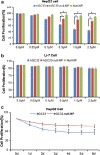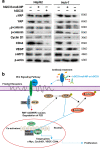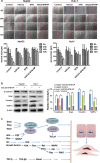hGC33-Modified and Sorafenib-Loaded Nanoparticles have a Synergistic Anti-Hepatoma Effect by Inhibiting Wnt Signaling Pathway
- PMID: 33242103
- PMCID: PMC7691417
- DOI: 10.1186/s11671-020-03451-5
hGC33-Modified and Sorafenib-Loaded Nanoparticles have a Synergistic Anti-Hepatoma Effect by Inhibiting Wnt Signaling Pathway
Abstract
Delivery of tumor-specific inhibitors is a challenge in cancer treatment. Antibody-modified nanoparticles can deliver their loaded drugs to tumor cells that overexpress specific tumor-associated antigens. Here, we constructed sorafenib-loaded polyethylene glycol-b-PLGA polymer nanoparticles modified with antibody hGC33 to glypican-3 (GPC3 +), a membrane protein overexpressed in hepatocellular carcinoma. We found that hGC33-modified NPs (hGC33-SFB-NP) targeted GPC3+ hepatocellular carcinoma (HCC) cells by specifically binding to GPC3 on the surface of HCC cells, inhibited Wnt-induced signal transduction, and inhibited HCC cells in G0/1 by down-regulating cyclin D1 expression, thus attenuating HCC cell migration by inhibiting epithelial-mesenchymal transition. hGC33-SFB-NP inhibited the migration, cycle progression, and proliferation of HCC cells by inhibiting the Ras/Raf/MAPK pathway and the Wnt pathway in tandem with GPC3 molecules, respectively. hGC33-SFB-NP inhibited the growth of liver cancer in vivo and improved the survival rate of tumor-bearing mice. We conclude that hGC33 increases the targeting of SFB-NP to HCC cells. hGC33-SFB-NP synergistically inhibits the progression of HCC by blocking the Wnt pathway and the Ras/Raf/MAPK pathway.
Keywords: Glypican-3; Hepatocellular carcinoma; Targeted therapy; Wnt signal.
Conflict of interest statement
The authors declare that they have no competing interests.
Figures









Similar articles
-
Engineered E. coli OMVs Carrying the Membrane-Binding hGC33 Fragment Precisely Target Liver Cancer and Effectively Treat Tumor.Int J Nanomedicine. 2025 May 22;20:6573-6590. doi: 10.2147/IJN.S513508. eCollection 2025. Int J Nanomedicine. 2025. PMID: 40433120 Free PMC article.
-
Anti-GPC3 antibody-modified sorafenib-loaded nanoparticles significantly inhibited HepG2 hepatocellular carcinoma.Drug Deliv. 2018 Nov;25(1):1484-1494. doi: 10.1080/10717544.2018.1477859. Drug Deliv. 2018. PMID: 29916268 Free PMC article.
-
Recombinant immunotoxin targeting GPC3 is cytotoxic to H446 small cell lung cancer cells.Oncol Lett. 2021 Mar;21(3):222. doi: 10.3892/ol.2021.12483. Epub 2021 Jan 21. Oncol Lett. 2021. PMID: 33613711 Free PMC article.
-
Glypican-3: a marker and a therapeutic target in hepatocellular carcinoma.FEBS J. 2013 May;280(10):2471-6. doi: 10.1111/febs.12126. Epub 2013 Jan 31. FEBS J. 2013. PMID: 23305321 Review.
-
Glypican-3: A promising biomarker for hepatocellular carcinoma diagnosis and treatment.Med Res Rev. 2018 Mar;38(2):741-767. doi: 10.1002/med.21455. Epub 2017 Jun 16. Med Res Rev. 2018. PMID: 28621802 Review.
Cited by
-
In Vivo and In Vitro Models of Hepatocellular Carcinoma: Current Strategies for Translational Modeling.Cancers (Basel). 2021 Nov 8;13(21):5583. doi: 10.3390/cancers13215583. Cancers (Basel). 2021. PMID: 34771745 Free PMC article. Review.
-
Sorafenib-Based Drug Delivery Systems: Applications and Perspectives.Polymers (Basel). 2023 Jun 9;15(12):2638. doi: 10.3390/polym15122638. Polymers (Basel). 2023. PMID: 37376284 Free PMC article. Review.
-
Nano-revolution in hepatocellular carcinoma: A multidisciplinary odyssey - Are we there yet?World J Hepatol. 2024 May 27;16(5):684-687. doi: 10.4254/wjh.v16.i5.684. World J Hepatol. 2024. PMID: 38818296 Free PMC article.
-
Engineered E. coli OMVs Carrying the Membrane-Binding hGC33 Fragment Precisely Target Liver Cancer and Effectively Treat Tumor.Int J Nanomedicine. 2025 May 22;20:6573-6590. doi: 10.2147/IJN.S513508. eCollection 2025. Int J Nanomedicine. 2025. PMID: 40433120 Free PMC article.
-
ETS-1/c-Met drives resistance to sorafenib in hepatocellular carcinoma.Am J Transl Res. 2023 Feb 15;15(2):896-913. eCollection 2023. Am J Transl Res. 2023. PMID: 36915773 Free PMC article.
References
-
- Mingqian F, Wei G, Ruoqi W, Weizao C, Yan-Gao M, William DF, Xin WW, Dimiter SD, Mitchell H. Therapeutically targeting glypican-3 via a conformation-specific single-domain antibody in hepatocellular carcinoma. Proc Natl Acad Sci USA. 2013;110(12):E1083–E1091. doi: 10.1073/pnas.1217868110. - DOI - PMC - PubMed
Grants and funding
- NO.202004j07020053/Anhui Provincial Science and Technology program
- NO. KJ2018ZD011/University Natural Science Research Project of Anhui Province
- NO. 82071862/The National Natural Science Fund of China
- 81872017/The National Natural Science Fund of China
- 81572431/The National Natural Science Fund of China
LinkOut - more resources
Full Text Sources
Research Materials
Miscellaneous

